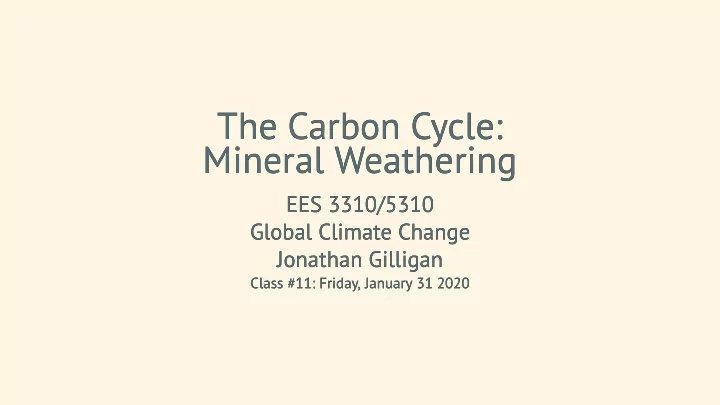

The Carbon Cycle: The Carbon Cycle: Mineral Weathering Mineral Weathering EES 3310/5310 EES 3310/5310 Global Climate Change Global Climate Change Jonathan Gilligan Jonathan Gilligan Class #11: Class #11: Friday, January 31 Friday, January 31 2020 2020
Ice Ages Ice Ages
25,000 years ago 25,000 years ago Image credit: Ron Blakey
25,000 years ago 25,000 years ago Image credit: Ron Blakey
Causes Causes
Timing of Ice Ages Timing of Ice Ages
Question Question Why would the summer sunlight in the far northern hemisphere be so important?
Northern vs. Southern Hemisphere Northern vs. Southern Hemisphere Image Credit: Pearson Education, Inc.
Ice Age Feedbacks Ice Age Feedbacks
Ice Age Feedbacks Ice Age Feedbacks Orbital cycles match timing of ice ages Changes in sunlight are too small to explain temperature changes There must be positive feedbacks to amplify them
Ice-Age Feedbacks: Ice-Age Feedbacks: Temperature starts to fall Glaciers grow higher albedo → drops weaker greenhouse CO 2 → Colder Temperature starts to rise Glaciers retreat higher albedo → rises stronger greenhouse CO 2 → Warmer Without and ice-albedo feedbacks, ice-ages couldn’t happen CO 2 Ice ages can’t happen with today’s levels. CO 2
Theory of Feedbacks Theory of Feedbacks Image credit: J. Hansen et al ., Phil. Trans. Royal Soc. A 371 , 20120294 (2013) doi:10.1098/rsta.2012.0294
Theory vs. Observations Theory vs. Observations Image credit: J. Hansen et al ., Phil. Trans. Royal Soc. A 371 , 20120294 (2013) doi:10.1098/rsta.2012.0294
The Oceans Breathe The Oceans Breathe
The Oceans Breathe The Oceans Breathe Solubility pump: Solubility pump: Temperature rises: CO 2 moves from ocean to atmosphere. Temperature falls: CO 2 moves from atmosphere to ocean. Positive feedback Positive feedback
Biological Pump Biological Pump Image credit: US Joint Global Ocean Flux Study
Structure of the ocean Structure of the ocean
Structure of the ocean Structure of the ocean Lower Atmosphere: Lower Atmosphere: Heated from bottom Sunlight absorbed at bottom (ground) Warmer at bottom Unstable well-mixed → Ocean: Ocean: Heated from top Sunlight absorbed at top (sea-surface) Warmer at top Thermocline as barrier to mixing Surface layer mixed by wind Deep ocean poorly mixed Image credit: Wikimedia
Ocean Carbon Cycle Ocean Carbon Cycle Numbers: Numbers: Air Upper ocean: ⇔ 1000 GT carbon in upper ocean Very fast: 92 GT/year from atmosphere Upper Deep ocean: ⇔ 38,000 GT carbon in deep ocean Slow: 6 GT/year from upper ocean GT = billion metric tons 1 GT water is a cube 1 kilometer on each side 1000 GT water is a cube 10 km (6 miles) on each side
The Rocks Breathe The Rocks Breathe
The Rocks Breathe The Rocks Breathe Carbonate vs. Silicate minerals Urey Reaction: CaSi O 3 + CO 2 ⇔ CaC O 3 + Si O 2 weathering (reactions near surface) ⇒ metamorphism (high temp./pressure deep beneath surface) ⇐ Silicate minerals formed at high temperature (igneous) Carbonate minerals formed at low temperature (sedimentary)
Why this is important Why this is important Rain falls on silicate minerals CO 2 dissolves into rainwater Dissolved CO 2 makes rainwater is acidic Acidic water dissolves silicate minerals Dissolved ions ( , , etc.) Ca +2 SiO − 2 In oceans, plankton convert dissolved CO 2 & ions to calcite (calcium carbonate) 3 Calcite ends up as limestone on sea floor Bottom line: Weathering silicate minerals transforms atmospheric CO 2 to rocks on sea floor. Detailed chemistry on Monday
Weathering as Thermostat Weathering as Thermostat CO 2 is balance of volcanic outgassing and chemical weathering Temperature rises: More rain, faster chemical reactions Faster weathering Atmospheric CO 2 falls Temperature falls Temperature falls Less rain, slower chemical reactions Slower weathering Atmospheric CO 2 rises Temperature rises Net effect: Keeps temperature stable near some “set point” Set-point is determined by geology
Temperature of Earth Temperature of Earth As long as outgassing is constant, weathering acts as thermostat. Earth’s temperature has been remarkably stable over time. Change of volcanic outgassing changes “setting” of thermostat.
Temperature of Mars and Venus Temperature of Mars and Venus Mars used to be warm. Now it is frozen. Why? Volcanic outgassing stopped. All CO 2 converted to rocks. No new CO 2 from volcanoes. Venus is scorching hot Why? Runaway greenhouse: All water evaporated Chemical weathering stopped Volcanic outgassing/metamorphism converted all carbonate minerals to CO 2 gas.
Recommend
More recommend